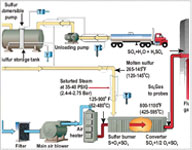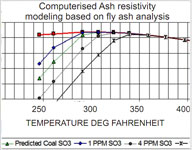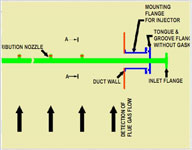![]()

![]()
Flue Gas Conditioning Systems
Flue Gas Conditioning Systems
Injecting conditioning agents of SO3 or NH3 or SO3 / NH3 modify the fly ash properties such as resistivity, agglomeration and cohesitivity. In some plants water is also added in the form of spray, which increases the surface conductivity of the dust. The effect is to improve the precipitation rate parameter thereby resulting in reduction in collection area. However, for effective performance of a Flue Gas Conditioning System (FGC)
Sufficient treatment time
Optimum dosing
Even distribution of the reagent are to be ensured
In a retrofit application, sufficient space may not be available between the air preheater and precipitator hence the system may not perform the way it has to perform. The conditioning process can sometimes adversely get affected by baffle plates and similar devices placed inside the duct conveying system, the quality of the collected dust and also excess opacity. The undesirable aspects outlined above, if addressed properly, the flue gas conditioning is good preposition in combating emission.
The plants at GNDP Bhatinda 3 & 4 - 2 x 210 MW, Ukai 4-1 x 210 MW, Kolaghat 1 x 210 MW - are retrofitted with NH3 conditioning system.
NTPC has installed the FGC system in a green field plant at Rihand 3 & 4 - 2 x 500 MW and vindhyachal 7-1 x 500 MW as stand by.
CSIPL have got both AFGC (Ammonia Flue Gas Conditioning) by signing a technology transfer agreement with Heavy Water Board under minister of Atomic Energy, who has got a patent on this. At the same time, we have a collaboration agreement with M/S EESERV, USA for supply of DFGC (Simultaneously injection of ammonia and SO3 vapors at ESP inlet) plants in India.
CSIPL have already supplied AFGC plant to MSPGCL, Koradi Unit 7, 210 MW Unit.
Because of the acidic nature of Indian fly ash AFGC is more popular and effective as compared to DFGC.



